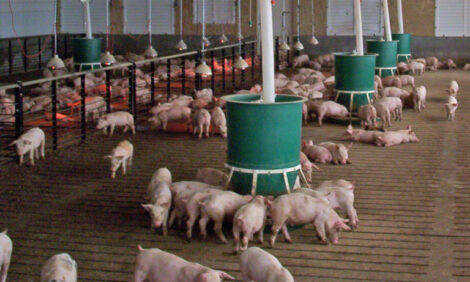



Increase of MRSA and Unusual Type Found in Slaughter Pigs in Switzerland
Researchers based in Bern demonstrated a significant and nearly three-fold increase of in the prevalence of methicillin-resistant Staphylococcus aureus (MRSA) in Swiss pigs within two years. Their study is also the first to describe the presence of MRSA ST49 in slaughter pigs.In years past, MRSA has been frequently detected in pigs in Europe, North America and Asia, according to Gudrun Overesch of the University of Bern and co-authors there and at the Swiss Federal Veterinary Office in a paper published recently in BMC Veterinary Research. They explain that recent, yet sporadic studies have revealed a low occurrence of MRSA in Switzerland.
In 2009, a monitoring survey of the prevalence and genetic diversity of MRSA in slaughter pigs in Switzerland was conducted using methods recommended by the EU guidelines, and a sampling strategy evenly distributed throughout the year and representative of the Swiss slaughter pig population. Monitoring was aimed to determine if the overall prevalence of MRSA in the entire country is increasing over the years and if specific multi-resistant MRSA clones are spreading over the country.
In 2009, the nasal cavities of eight out of 405 randomly selected pigs were positive for MRSA, representing a prevalence of 2.0 per cent (95 per cent CI: 0.9 to 3.9). The following year, 23 out of 392 pigs were positive for MRSA (5.9 per cent prevalence; 95 per cent CI, 3.8 to 8.7).
Three multi-locus sequence types (ST), four spa types and two types of staphylococcal cassette chromosome mec (SCCmec) elements were detected. The most frequent genotypes were ST398 (MLST)-(spa)t034-V(SCCmec) (n=18) and ST49-t208-V (n=7), followed by ST398-t011-V (n=4), ST398-t1451-V (n=1), and ST1-t2279-IVc (n=1).
The isolates displayed resistance to β-lactams [mecA, (31/31); blaZ, (19/31)]; tetracycline [tet(M), (31/31); tet(K), (30/31)] (n=31); macrolides and lincosamides [erm(C) (4/31) or erm(A) (18/31)] (n=22); tiamulin [vga(A)v (9/31) or unknown mechanism (18/31)] (n=27); trimethoprim [dfr(G) (18/31); spectinomycin [ant(9)-Ia (19/31) or unknown mechanism (3/31)] (n=22); streptomycin [str (19/31)]; sulphamethoxazole (7/31) and ciprofloxacin (n=1). The mechanisms not determined.
This study is the first to describe the presence of MRSA ST49 in slaughter pigs, and to demonstrate a significant and nearly three-fold increase of MRSA prevalence in pigs within two years, concluded Overesch and co-authors. The presence of a specific clonal lineage of MRSA from Switzerland suggests that it has been selected in Swiss pig husbandry. The researchers recommend that effective hygiene measures should be enhanced within the entire pig production chain to suppress the spread of these pathogens into the community.
Reference
Overesch G., S. Büttner, A. Rossano and V. Perreten. 2011. The increase of methicillin-resistant Staphylococcus aureus (MRSA) and the presence of an unusual sequence type ST49 in slaughter pigs in Switzerland. BMC Veterinary Research, 7:30 doi:10.1186/1746-6148-7-30
Further Reading
| - | You can view the full report by clicking here. |
August 2011








